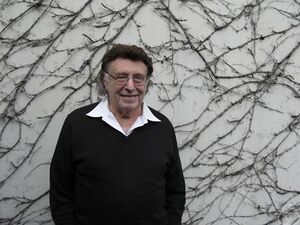Bertram Kostant (nonfiction): Difference between revisions
(Created page with "thumb|Bertram Kostant.'''Bertram Kostant''' (May 24, 1928 – February 2, 2017) was an American mathematician. Kostant grew up in New York City,...") |
No edit summary |
||
| (One intermediate revision by the same user not shown) | |||
| Line 5: | Line 5: | ||
After time at the Institute for Advanced Study, Princeton University, and the University of California, Berkeley, he joined the faculty at the Massachusetts Institute of Technology, where he remained until his retirement in 1993. | After time at the Institute for Advanced Study, Princeton University, and the University of California, Berkeley, he joined the faculty at the Massachusetts Institute of Technology, where he remained until his retirement in 1993. | ||
Kostant's work | Kostant's work involved [[Representation theory (nonfiction)|representation theory]], Lie groups, Lie algebras, homogeneous spaces, differential geometry and mathematical physics, particularly symplectic geometry. He gave several lectures on the Lie group E8. | ||
He | He was been one of the principal developers of the theory of [[Geometric quantization (nonfiction)|geometric quantization]]. | ||
His introduction of the theory of prequantization | His introduction of the theory of prequantization led to the theory of quantum Toda lattices. | ||
The Kostant partition function is named after him. | The Kostant partition function is named after him. | ||
With Gerhard Hochschild and Alex F. T. W. Rosenberg, he is one of the namesakes of the Hochschild–Kostant–Rosenberg theorem which describes the Hochschild homology of some algebras. | With [[Gerhard Hochschild (nonfiction)|Gerhard Hochschild]] and [[Alex F. T. W. Rosenberg (nonfiction)|Alex F. T. W. Rosenberg]], he is one of the namesakes of the Hochschild–Kostant–Rosenberg theorem which describes the Hochschild homology of some algebras. | ||
His students include James Harris Simons, James Lepowsky, Moss Sweedler, David Vogan, and Birgit Speh. At present (January 2018) he has more than 100 mathematical descendants. | His students include James Harris Simons, James Lepowsky, Moss Sweedler, David Vogan, and Birgit Speh. At present (January 2018) he has more than 100 mathematical descendants. | ||
| Line 32: | Line 32: | ||
== Nonfiction cross-reference == | == Nonfiction cross-reference == | ||
* [[Geometric quantization (nonfiction)]] | |||
* [[Gerhard Hochschild (nonfiction)]] - Colleague | |||
* [[James Lepowsky (nonfiction)]] - Doctoral student | |||
* [[Mathematics (nonfiction)]] | * [[Mathematics (nonfiction)]] | ||
* [[Arlie Petters (nonfiction)]] - Doctoral student | |||
* [[Stephen Rallis (nonfiction)]] - Doctoral student | |||
* [[Alex F. T. W. Rosenberg (nonfiction)]] - Colleague | |||
* [[Irving Segal (nonfiction)]] - Doctoral advisor | |||
* [[James Harris Simons (nonfiction)]] - Doctoral student | |||
* [[Birgit Speh (nonfiction)]] - Doctoral student | |||
* [[Moss Sweedler (nonfiction)]] - Doctoral student | |||
* [[David Vogan (nonfiction)]] - Doctoral student | |||
External links: | External links: | ||
Latest revision as of 18:46, 23 January 2018
Bertram Kostant (May 24, 1928 – February 2, 2017) was an American mathematician.
Kostant grew up in New York City, where he graduated from Stuyvesant High School in 1945. He went on to obtain an undergraduate degree in mathematics from Purdue University in 1950. He earned his Ph.D. from the University of Chicago in 1954, under the direction of Irving Segal, where he wrote a dissertation on representations of Lie groups.
After time at the Institute for Advanced Study, Princeton University, and the University of California, Berkeley, he joined the faculty at the Massachusetts Institute of Technology, where he remained until his retirement in 1993.
Kostant's work involved representation theory, Lie groups, Lie algebras, homogeneous spaces, differential geometry and mathematical physics, particularly symplectic geometry. He gave several lectures on the Lie group E8.
He was been one of the principal developers of the theory of geometric quantization.
His introduction of the theory of prequantization led to the theory of quantum Toda lattices.
The Kostant partition function is named after him.
With Gerhard Hochschild and Alex F. T. W. Rosenberg, he is one of the namesakes of the Hochschild–Kostant–Rosenberg theorem which describes the Hochschild homology of some algebras.
His students include James Harris Simons, James Lepowsky, Moss Sweedler, David Vogan, and Birgit Speh. At present (January 2018) he has more than 100 mathematical descendants.
Kostant's many honors include election to the National Academy of Sciences in 1978. In 2012 he became a fellow of the American Mathematical Society.
In the News
Fiction cross-reference
Nonfiction cross-reference
- Geometric quantization (nonfiction)
- Gerhard Hochschild (nonfiction) - Colleague
- James Lepowsky (nonfiction) - Doctoral student
- Mathematics (nonfiction)
- Arlie Petters (nonfiction) - Doctoral student
- Stephen Rallis (nonfiction) - Doctoral student
- Alex F. T. W. Rosenberg (nonfiction) - Colleague
- Irving Segal (nonfiction) - Doctoral advisor
- James Harris Simons (nonfiction) - Doctoral student
- Birgit Speh (nonfiction) - Doctoral student
- Moss Sweedler (nonfiction) - Doctoral student
- David Vogan (nonfiction) - Doctoral student
External links:
- Bertram Kostant @ Wikipedia
